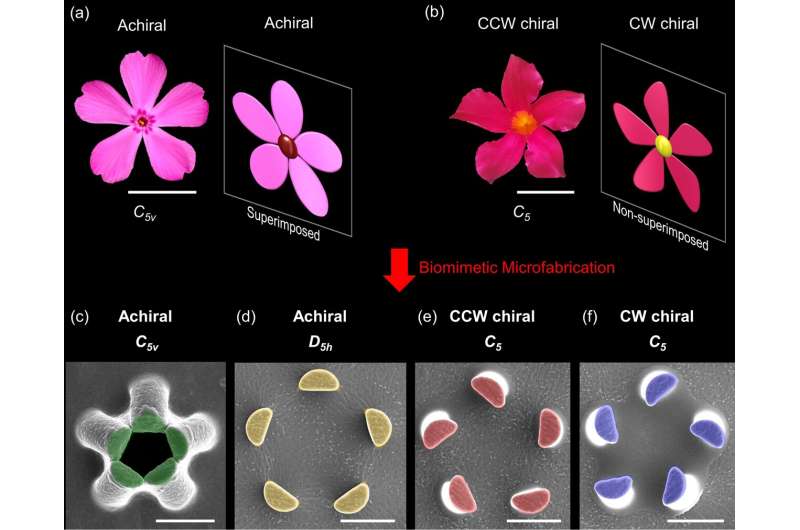Three-dimensional flower corollas with on-demand chiral selectivity

Researchers from Hanyang University have recently designed a three-dimensional (3D) microarray with dynamic chirality selection.
Chirality is a non-superimposable property of structure; for example, the left hand looks like the right in a mirror, yet the left hand cannot be superimposed by the right. Chiral structures have been studied in the biochemical field as part of the search for drugs that bind with DNA proteins. Artificial fabrication of chiral structures has been attempted for functionality from chiral selectivity; however, it is difficult to dynamically switch the chirality.
A flower corolla-inspired study, published in ACS Nano, is the first to demonstrate on-demand and dynamically controlled chiral selectivity of a 3D microstructure. The researchers were inspired by the chirality of the flower corolla, so often visible in nature. Flowers like the Mandevilla protect themselves against heavy winds via the chirality of its five-petaled corolla. This chiral corolla uses a counterclockwise directionality with asymmetric-shaped petals. Alternatively, flowers like Phlox subulata do not have chirality since this five-petaled corolla superimposes with its mirror image with symmetric-shaped petals. This is called achirality.
In the flower corolla-inspired 3D microstructure, five semicylindrical micropillars are radially arranged to mimic a natural flower consisting of five petals. This microarray is an achiral structure due to its symmetrically shaped semicylindrical micropillars. A key point of this work is that this achirality of the microarray can then dynamically disappear through the twisting of the micropillars that converts its symmetrical shape into an asymmetrical one.
The micropillars are composed of easily deformable rubber-like polydimethylsiloxane and magnetic iron particles; thus, the pillar tops twist when a magnetic field is applied while pillar bases remain fixed to the substrate of microarrays. With the start of twisting actuations, the microarray does not superimpose with its mirror image.
Consequently, the achirality of the microarray changes in real-time to counterclockwise or clockwise chirality by clockwise or counterclockwise twisting actuations, respectively. Micropillars in an array simultaneously twist in a clockwise direction, resulting in counterclockwise chirality. Conversely, clockwise chirality is led by micropillars that simultaneously twist in a counterclockwise direction.
Researchers in the study emphasize a key aspect of this technique in that simply regulating the direction of magnetic fields can dynamically convert chiralities of the microarrays from counterclockwise to clockwise directionality and vice versa.
This chiral-selective three-dimensional microstructure has possible applications in the development of optic devices. Typically, electromagnetic waves of light are circularly polarized, separated into right- or left- circularly polarized lights and interact with the chirality of the structure.
Through this chiral-selective interaction, the polarization direction of arbitrary light could be detected as light penetrates into the chiral microarray. Right- or left-circularly polarized light will selectively interact with the counterclockwise or clockwise chirality of the flower corolla-like microarray.
More information: Jeong Eun Park et al, On-Demand Dynamic Chirality Selection in Flower Corolla-like Micropillar Arrays, ACS Nano (2022). DOI: 10.1021/acsnano.2c04825
Journal information: ACS Nano
Provided by Hanyang University




















